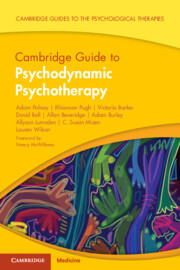Book contents
- Cambridge Guide to Psychodynamic Psychotherapy
- Cambridge Guides to the Psychological Therapies
- Reviews
- Cambridge Guide to Psychodynamic Psychotherapy
- Copyright page
- Dedication
- Contents
- Foreword
- Preface
- A Note from the Series Editor
- Acknowledgements
- Part 1: An Overview of the Model
- Part 2: The Model of Psychodynamic Psychotherapy into Practice
- Part 3: Application for Mental Health Presentations
- Part 4: Application of Psychodynamic Psychotherapy in Different Populations and in Different Settings
- Beyond 1:1 Therapy: Working Psychodynamically with Clinicians, Teams, and Organisations
- Other Forms and Settings of Psychotherapeutic Work
- Chapter 20 A Psychodynamic Approach to Working with People Experiencing Multiple Exclusion Homelessness
- Chapter 21 Psychodynamic Psychotherapy Online and by Phone
- Chapter 22 Group Analysis and its Applications
- Glossary of Terms
- Index
- References
Chapter 22 - Group Analysis and its Applications
from Other Forms and Settings of Psychotherapeutic Work
Published online by Cambridge University Press: 25 August 2023
- Cambridge Guide to Psychodynamic Psychotherapy
- Cambridge Guides to the Psychological Therapies
- Reviews
- Cambridge Guide to Psychodynamic Psychotherapy
- Copyright page
- Dedication
- Contents
- Foreword
- Preface
- A Note from the Series Editor
- Acknowledgements
- Part 1: An Overview of the Model
- Part 2: The Model of Psychodynamic Psychotherapy into Practice
- Part 3: Application for Mental Health Presentations
- Part 4: Application of Psychodynamic Psychotherapy in Different Populations and in Different Settings
- Beyond 1:1 Therapy: Working Psychodynamically with Clinicians, Teams, and Organisations
- Other Forms and Settings of Psychotherapeutic Work
- Chapter 20 A Psychodynamic Approach to Working with People Experiencing Multiple Exclusion Homelessness
- Chapter 21 Psychodynamic Psychotherapy Online and by Phone
- Chapter 22 Group Analysis and its Applications
- Glossary of Terms
- Index
- References
Summary
Group Analysis is a particular approach to group psychotherapy as developed by S. H. Foulkes. Key influences and shared ground with other approaches are noted. This brief overview focuses largely on key constituents of the setting and format of group analysis as a psychological treatment. The group analyst, referred to as the conductor, and their dual roles of group administrator and group therapist are briefly explored. Vignettes show this therapeutic approach, in both therapeutic and non-clinical settings. Some key group analytic phenomena are illuminated as is the minimally interventive, analytical approach of the conductor. We encounter ‘John’ at three key stages namely pre-group preparation, joining a new group, and a preparing to leave the group. The conductor’s responsibilities are explored, specifically their intention to help the group develop a therapeutic culture, where dependence on the group conductor is replaced by a greater connectedness to each other. The conductor’s ability to trust the group to find its way is noted while their role in helping this process is not undervalued. Communication, both conscious and unconsciously is a central concern of the group analytic approach.
- Type
- Chapter
- Information
- Cambridge Guide to Psychodynamic Psychotherapy , pp. 310 - 321Publisher: Cambridge University PressPrint publication year: 2023



